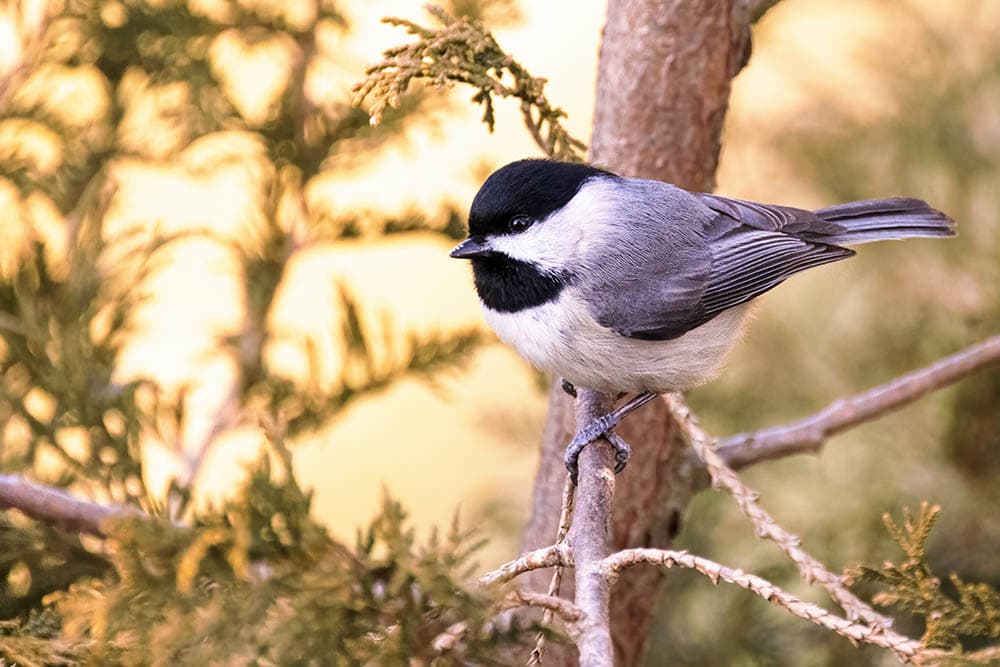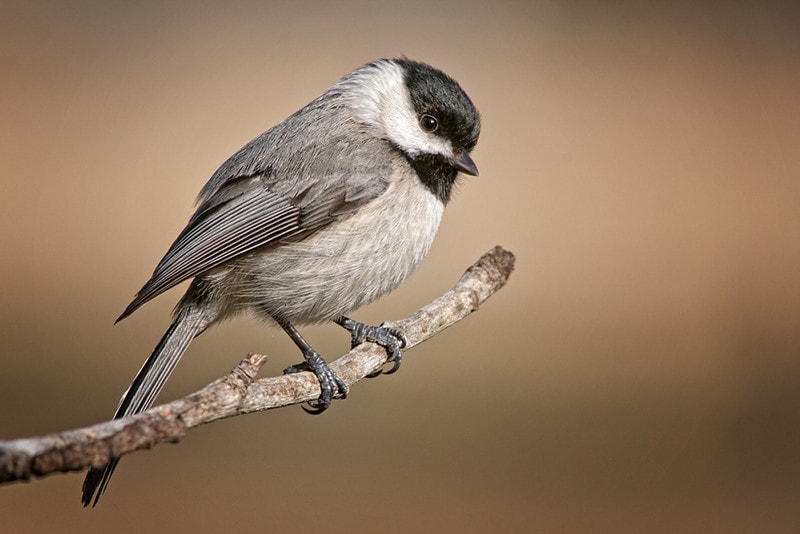Carolina Chickadee: Field Guide, Pictures, Habitat & Info
Last Updated on

The Carolina Chickadee looks very similar to the Black-Capped Chickadee with a black cap and bib, gray back and wings, and a white belly. These two similar species of songbirds do have some overlap in their region, in which case the Carolina Chickadee lives at lower altitudes. Their similarities and the fact that they will each learn the song of the other can cause some confusion for birdwatchers, but the Carolina Chickadee is considered a good beginner bird for watchers because it tends to attract other birds for spotting, too.
Carolina Chickadees will use nesting boxes and may come to feeders for seed and suet, but they prefer to take their haul away and eat in a nearby tree.

Quick Facts about Carolina Chickadees

| Habitat | Forests |
| Diet | Insects, seeds, fruit, berries |
| Behavior | Lively |
| Nesting | Tree cavities |
| Conservation | Least concern |
| Scientific name | Poecile carolinensis |
| Lifespan: | 8 years |
Carolina Chickadee General Description
The Carolina Chickadee is an inquisitive, lively, and athletic bird with a fairly distinctive call, although it can be confused with the Black-Capped Chickadee, which it also looks very similar to. Although it is an inquisitive bird and may visit feeders, it can be difficult to attract and prefers platform feeders from where it can grab seeds before disappearing to a nearby tree branch to eat. They have black caps and bibs, like the Black-Capped Chickadee, with a gray back and wings and a white belly.
Carolina Chickadee Range, Habitat, Behavior, Diet & Nesting
Chickadees are members of the tit family and are songbirds. Like all songbirds, they have toes that enable them to grip onto branches for balance and to feed and rest. They also all have the capability to sing, although there is a varied range of songs according to the particular species.
Range
Found throughout the Southeast U.S., the Carolina Chickadee is the only species of chickadee found in Florida. Its habitat does overlap that of the Black-Capped Chickadee in the Appalachians, causing some confusion among birdwatchers. Where the two do overlap, they may breed, resulting in the hybridization of species, but the Carolina Chickadee will usually live at lower elevations in these shared zones.
Habitat
Preferring the cover of leafy trees like oaks, Carolina Chickadees can usually be found in forests and forested areas. They will also live in suburbs with a high concentration of leafy trees, which means that they can be quite easily seen in some parts of the country.

Behavior
The chickadee is a lively, active, and inquisitive bird. Its toes mean that it is capable of gripping onto branches and can be seen hanging upside down to forage. It may also be seen catching some insect prey in flight. During winter, these birds flock together, and every member of the flock is ranked. The highest ranked members remain to nest in the area while lower ranked birds travel to find nesting sites, and many do not nest at all. The species is non-migratory and can be seen in its range throughout the year.
Diet
With a primary diet of insects, the Carolina Chickadee will forage for insects in tree bark and on branches and the foliage of trees. It will also eat some berries and acorns, and while the species does most of its foraging up in trees, it can occasionally be seen on the ground looking for food.
Nesting
Mating pairs of Carolina Chickadees will usually form in fall before staying together in their winter flocks with the senior and higher ranking members of that flock staying in the area to nest. The birds will nest in small holes in trees but may also nest in holes in fences and structures, and they will take to well-situated nesting boxes.
How to Find Carolina Chickadees: Birdwatching Tips
There can be some confusion between the Carolina Chickadee and the Black-Capped Chickadee, although this should only occur in the Appalachians because this is the only area where the two species coexist. Confusion can arise because the breeds look similar, can learn the other’s song, and may hybridize.
What to Listen For
The song of the Carolina Chickadee consists of a high-pitched and a lower-pitched note and it differs from a lot of other chickadee species because it only has two notes rather than three.
What to Look For
With a black bib and head, white underbelly, gray wings, and white cheeks, the Carolina Chickadee has the same markings as the Black-Capped Chickadee, although its song is usually different.

When to Look
The bird is non-migratory. It can be seen individually or in pairs throughout most of the year, and, in winter, it can be seen as part of a winter flock consisting of potentially dozens of birds.
Attracting Carolina Chickadees to Your Backyard: Tips & Tricks
Chickadees can be very friendly and may even be trained to take food from your hand, although the Carolina Chickadee is a little more reluctant to get those close to people. However, to attract this attractive little songbird to your garden, you can try these tips:
- Provide sunflower seeds, peanuts, and mealworms to meet the dietary preferences of seeds, nuts, and insects.
- Try feeders that are inaccessible to large birds. This will prevent the smaller chickadee from being intimidated by woodpeckers and other large feeders.
- Place the feeders near trees and shrubs. This type of bird prefers to take seed and disappear to a nearby branch to eat it, rather than consuming it directly on the feeder.
- Leave dead trees and dead limbs on trees. Chickadees find it easy to nest in and improve nests in dead trees, so if you habitually remove every dead limb as soon as they appear, you are limiting a chickadee’s nesting options and it will likely look elsewhere.
- Install nesting boxes and birdhouses for these cavity nesters. They are regularly found nesting in such boxes and they will provide you with the opportunity to see them gathering nesting material and hopping in and out of the house.
Carolina Chickadee Conservation: Is This Bird Threatened?
The species is considered to be of least concern, which means that its numbers have not reached dangerously low levels. However, the population of this species has decreased by approximately 16% since the 1960s. It is believed there are approximately 13 million breeding examples of this species.

Final Thoughts
The Carolina Chickadee is a member of the tit family. This small songbird shares a lot of similarities with the Black-Capped Chickadee, including its markings. The two breeds’ territories also overlap, and they may learn one another’s song, which can cause confusion. However, the pretty bird can be attracted to gardens using appropriate feeders stocked with suitable food and through the installation of nesting boxes and birdhouses.
See also:
- Boreal Chickadee: Field Guide, Pictures, Habitat & Info
- Boreal vs Black-Capped Chickadee: How to Tell the Difference
Featured Image Credit: Ami Parikh, Shutterstock
About the Author Robert Sparks
Robert’s obsession with all things optical started early in life, when his optician father would bring home prototypes for Robert to play with. Nowadays, Robert is dedicated to helping others find the right optics for their needs. His hobbies include astronomy, astrophysics, and model building. Originally from Newark, NJ, he resides in Santa Fe, New Mexico, where the nighttime skies are filled with glittering stars.
Related Articles:
10 Types of Hummingbirds in Arkansas (With Pictures)
8 Types of Hummingbirds in Nebraska (With Pictures)
5 Types of Hummingbirds in Idaho (With Pictures)
3 Types of Hummingbirds in Mississippi (With Pictures)
8 Types of Hummingbirds in Kansas (With Pictures)
5 Types of Hummingbirds in West Virginia (With Pictures)
5 Types of Hummingbirds in Ohio (With Pictures)
Where Do Nuthatches Nest? Nuthatch Nesting Habits Explained
